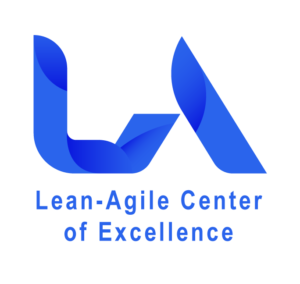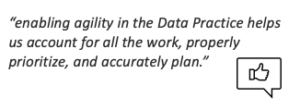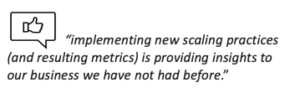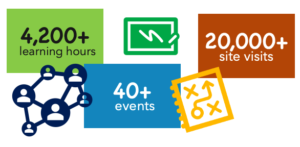How We Built a Bad-Ass Coaching Community Worldwide
5 C’s to Drive Powerful Coaching Outcomes and Scale a Coach Community
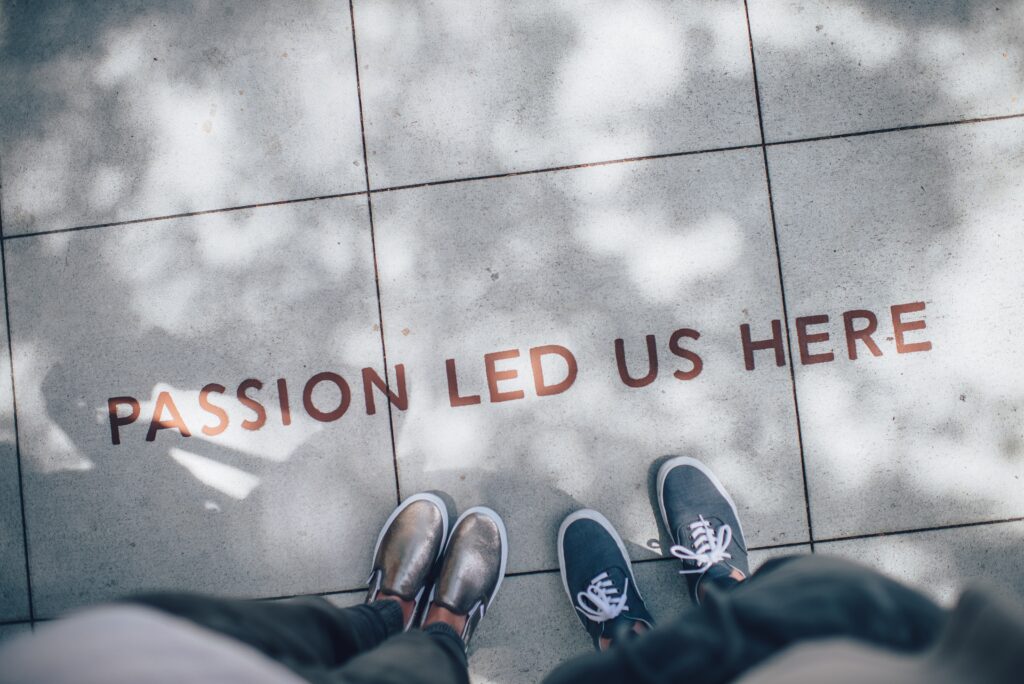
Last year, I was diagnosed with a serious medical condition. My unusual illness doesn’t show many outward symptoms, but it smolders away until it burns up a vital organ. I don’t look sick. But I am. However, that isn’t the focus of this post. This article is about how we built a Bad Ass Coaching Community to scale our coaching abilities and competencies worldwide. When I envisioned this strategy for pairing, sharing, and scaling, I knew there would likely be at least one person who would personally and professionally benefit from it. The fact that it would be me is what surprised me. Read on to learn what we did and what others said about our efforts.
Clarity
Our small coaching team in America partners with a larger group in India; we are all based in the engineering division of our company. Our US team has many decades of diverse coaching experience, but except for one person, we have an average of 1–2 years of company experience. So, the first thing we did was clarify everything. We created agile career paths and job descriptions for each level, paying particular attention to maturing expectations on how to advance an agile career. We collaborated with leadership and human resources in America and India to ensure we set consistent expectations across countries. Utilizing Pia-Maria Thorén’s People Agility principles, we focused our job descriptions on demonstrating competencies and potential as well as making an impact rather than listing accountabilities.
The Indian Agile Director and I persevered through a year of process hurdles to change our job names from project management titles to Lean-Agile titles. Some of you may be thinking, “Who cares what coaches are called?” but this became a critical conversation that helped align everyone with our new career paths and clarify expectations about our role with our stakeholders.
Cohesiveness
Identity. We developed a logo representing our new practice (with the assistance of a graphic artist!) And, since we coach that every team needs to have a vision, we created our own to reflect our values and help us realign to our north star when the path gets rocky. And we invested in spending time together to help move through the teaming phases.
Agility: It’s not just a job for us; it’s our passion.
We are professional coaches who are serious about influencing better ways of working. We serve others with curiosity, learning, and innovation.
Example: Over the year, we’ve held many icebreakers, played games, and generally got to know one another better. We’ve started to develop private jokes, vocabulary, and even some “safe for work” gestures (jazz hands!) Equally significant, we resolved several disagreements and emerged from them with a higher degree of communication, trust, and a couple of safe words!
Competencies
Launch. Our team attended Bob Galen’s Bad Ass Coaching Days, and we also created an internal Agile Summit of our own. In addition to team-building exercises, we took a few hours a day (about 12 hours total) for teaming, skill development, and creating the following year’s outcomes and measures.
Baseline and Goals. A cross-functional team consists of individuals with a variety of roles and competencies. So, we aimed to become cross-functional with a mix of strengths in various coaching specialties, such as portfolio, team, or product agility. We established a baseline for our individual coaching competencies using the Agile Coaching Growth Wheel. This created personal insights, and as a team, we built a shared vocabulary that helped us align with what the different stances meant for each of us. That helped us create a comprehensive skills marketplace and goals tailored to individual passions and interests. Then, we determined who to best partner with to help us grow and keep each other accountable.
Learning. Before closing our summit, we drafted a sequence of monthly learning events and facilitators so we would be sure to continue to invest in ourselves. We started the year by exploring techniques and coaching strategies to navigate complex topics like participatory facilitation, release forecasting, and navigating conflict. We took inspiration for several sessions from the “Extraordinarily Bad Ass Coaching” book by Bob Galen.
Example: We used Galen’s Coaching Arc template to prepare for a typical tough conversation (change, anyone?) and then used coaching dojos to role-play. Along the way, we explored how our personal meta-skills (one of Galen’s terms) helped or hindered us in our coaching. Galen provides pragmatic advice and helpful templates for these types of exercises in his “Bad Ass” book.
Pairing and sharing. Borrowing from the value proven with pair programming, we each partnered with another teammate throughout the year, so we always had backup and support.
Example: pairing to deliver workshops and training, helping facilitate team events, collaborating on documentation, and creating new materials.
We also held numerous reviews to demo our work and help each other. This practice provided many benefits to our teams and stakeholders, as they had multiple resources to turn to and coverage when someone was out of office.
Our buddy system also helped increase confidence and safety for coaches practicing new stances, like role-playing difficult conversations or staying positive through change management challenges.
Coach pairing was pivotal to scaling our new product planning practices worldwide. We typically have US-based coaches working with US-based teams and Indian coaches working with Indian teams. We spent time sharing our knowledge and demonstrating across countries, so we learned from each other, challenged the current experiments, and helped solve tool or data issues. Coach pairing also reinforced consistency in our coaching messages and new planning practices.
Pairing also helped us translate the patterns and practices that worked well in product engineering to data engineering. This was not a cut-and-paste activity; there was a lot of problem-solving for the different domains. But coach pairing across divisions helped ensure we didn’t reinvent things.
Feedback from others. A data leader had this to say about our coaches and our agile planning outcomes:
Later in the year, as our teams became busier with deliverables, we transitioned to micro-learning, using focused weekly objectives to hone and practice skills like storytelling and presenting.
Feedback from each other. A fun and valuable exercise was creating videos of our standard practices, like how we are using our workflow tool to plan and track dynamic release forecasts. We also practiced our presentation and storytelling skills with each other. Limiting ourselves to a 3-minute timebox for our videos and storytelling provided focus and helped us practice lean communication. Candid feedback sessions provided helpful criticism of both content and our public speaking. I don’t believe it would have been as effective without the teaming we did earlier in the year.
As a side note, I believe we tend to undervalue storytelling and public speaking as coaches and don’t practice enough until we are in high-stakes situations; I strongly advise investing in these skills! But I digress.
Community
So, are we a team or a group? My preference is the word community, with all that word evokes. We leveraged both planned and ad hoc learning events, as well as various types of sharing, to mature agility across our 11,000-member organization.
To allow everyone to showcase their dashboards, exchange tool expertise, and practice concepts like release forecasting before teaching larger audiences, we hosted reviews and demos between American and Indian coaches.
We offered opportunities for individuals to contribute to the organization in ways that aligned with their interests and career development goals, like through our core Community of Practice (CoP) committee.
We centered our CoP with two regular monthly events—our Pathfinder and Navigator series. (Through team building, we discovered we all enjoy hiking, so we capitalized on that similarity to add some flair to our language!) We hosted our events at 10 a.m. EST to cover the most time zones, including the US West Coast and India, and kept it on the same cadence to reduce complexity—every other week, the same day of the week. We avoided our synchronized Sprint Events week and adjusted the calendar as needed to support organizational events like our global hackathon. Recognizing that these times are only convenient for some, we recorded most presentations.
Our Pathfinder series focused on sharing. We seeded the conversation with a topic and interactive questions that helped kickstart fruitful conversations using a hybrid lean-coffee strategy, like “What does Predictable Delivery mean to you?” Then they showcased relevant successes.
Our Navigator series focused on learning. We invited external speakers in addition to our own presenters, using a quarterly theme to focus our topics, like “The Human Side of Agile,” which included a variety of presentations around safety and engagement.
Our learning labs focused on targeted role coaching, especially product ownership. A small group meets regularly for a short teaching block, hands-on practice, and homework to help absorb the recommended practices and material.
Example: Learning Lab topics include organizational metrics, role clarity, and planning practices. The group can also vote on various topics to explore, like discovery techniques.
We’ve held five 3-6-month learning labs in America, India, and Australia. These cohorts have aided in conveying our planning procedures and quality standards and have sparked insightful conversations around accountability and organizational design. Those who felt isolated in their roles got to know one another through this frequent and interactive touchpoint.
Feedback from others. One of the focuses of our learning was to introduce competencies to support our product agility outcomes, which resulted in a senior tech leader saying:
Training and workshops. We collaborated with our learning and development team to offer certification training and focused workshops through the organization’s training platform. We do not have access to this platform; therefore, one challenge we had was having to plan a training calendar for the entire upcoming year to allow our learning and development partners to post all the classes in the system at one time. The advantages of using this platform were that people could manage their registrations themselves and the vast organizational reach it provided. That visibility opened opportunities for people and teams outside of our direct influence in engineering, which then led to opportunities for coaching conversations and role growth across the organization.
Additionally, we augmented our workshops with third-party webinars available through our learning platform for those wanting to go further with their education. And, because of our investment in growing our training competency with our Train the Trainer program, participants experienced a consistent message, and events were held in regionally friendly time zones.
Methods: Our training employs adult education strategies that require participation to get the most value out of virtual learning. Therefore, we set expectations ahead of time that we would require cameras to be used and total attendance—no jumping in and out of the session. We sent tutorials for our online tools and several reminders to help prepare students. Because of the immersive nature, we required a minimum of 4 people to hold the course so we could use breakout sessions and participatory facilitation techniques to maximize the learning experience. We used the online collaborative tool called Mural in combination with either Zoom or Teams for videoconferencing. We did not record training because students were in breakout rooms about 50% of the time, which helped promote attendance, safety, and interaction.
Feedback from others: A product leader commented on our engagement and upskilling outcomes:
Micro-learning: Some other ways we created community were by presenting webinars to audiences like new hires and product and project managers that drove awareness of our material repository and training calendar. We also recorded brief video demos of some of our processes to post on our internal repository and use in training.
Results: Throughout the year, we facilitated more than 40 events, delivering more than 4,200 learning hours across the globe. Additionally, our online repository, where we published our best Community of Practice videos and continuously expanded our collection of job aids and demos, received hundreds of monthly visitors—20,000 visits last year!
Feedback from others A learning and development leader said this about our training outcomes: that we are…
Consistency
Occasionally, we need our leadership’s help to communicate significant changes. But we know agility can’t be copied and pasted across different divisions. We focused on attracting people to try practices that have succeeded inside our organization rather than trying to enforce them. We also know how frustrating it is for people if different coaches deliver conflicting messages. So, we worked together to ensure our coaching voice is consistent in areas that matter to our organization. This takes time and discipline, but the added advantage is the opportunity it provides us to identify and close knowledge gaps.
We define it. To define our playbook, we first discussed the problem to be solved, then experimented in one product area, and then documented the process for other teams to try.
Example: Our Epic template helps product partners create a lightweight business case and align on clear business drivers (revenue, strategy, or efficiency).
With our documentation, we weren’t trying to recreate the internet. We wrote short job aids or facilitation guides for topics specific to our organization and posted them on a central repository available for everyone to use. Taking the time and effort to document different practices helped ensure that our diverse, global audience interpreted things similarly. Our online playbook was proven to be very helpful when new people joined the organization or teams decided to improve their agility. The area of our playbook that received the most frequent visitors was our release planning process and templates.
We practice it. In the spirit of “working product over contracts,” we didn’t try to document every use case. Regular reviews and coaching dojos helped us refine the nuances through application. Our new library of short videos goes further to reinforce consistency.
Example: Epic burndown charts help show the progress of a release and if the scope needs to be changed. This requires a lot of consistent behavior across teams to be accurate.
If coaches were new to a practice or technique, we followed a three-step “I do, we do, you do” pattern to ensure they felt confident in coaching something new (like release forecasting) before facilitating it themselves.
We evolve it. A complex topic often benefits from a few iterations to simplify it. We’ve spent a year working to understand how we can best introduce dynamic release forecasting and the leanest data points that would be the most valuable for organizational reporting and decision-making. An indicator of success is when another group reaches out to use our practices or materials for themselves. It is even more satisfying if they help us improve them. That’s when we know we have a sustainable pattern.
Conclusion
Throughout the year, our crew experienced several life events. Many were momentous, like the birth of new agilists; others were for personal enjoyment, like traveling abroad; yet others were get-togethers with family and friends (Bowling Hall of Fame!). Every time someone was away, a pairing buddy was available to fill in, guide teams, and ensure events went smoothly.
And some had more significant health and medical problems, just like me. I am fortunate to have a knowledgeable and gifted physician who never gave up trying to navigate my test results. One hundred and thirty-nine tests and 11 biopsies later, I have a diagnosis and a course of treatment. Although I won’t be cured, my prognosis is good!
Taking a step back and letting go is maybe the best way to gauge how well a self-organizing, high-performing team is doing. I knew I could change my priorities and focus on my family and health as I prepared myself for a few months of a medical and medication regimen, along with a short leave of absence.
People reading this may think, “We just don’t have the time for all this learning and pairing!” Building a community takes time, and that is a trade-off, for sure. We invested 4–8 hours monthly on average, which is a small percentage considering the professional growth and outcomes we experienced. We paced ourselves: we did a lot of intensive learning early in the year but eased up throughout the summer months so we could practice our newer competencies; in the last quarter, we switched to micro-learning as our Summit was a major time investment. It also takes discipline. We ground ourselves in the principles of agility to keep it simple and experimental, but we stay disciplined (with Kanban.)
There is one thing I know for sure: I don’t lay awake at night worrying if we are delivering value or if there is a team without coverage because I know we’ve done the work.
Feedback from others: One tech lead had to say this about one of our coaches, and I believe the sentiment perfectly captures our year’s coaching outcome:
I hope our 5 C’s to build a Bad Ass Coaching Community help you if you are looking to scale your coaching. Let us know in the comments below what is working for you!
~Julee Everett
Hone your craft, speak your truth, and show your thanks
Visit my YouTube Channel for a growing library of people, products, and business agility resources
I unabashedly use Bob Galen’s tremendous body of work in this article (and title) because it has been incredibly valuable as a guide for maturing our Lean-Agile community. Don’t miss the opportunity to learn from his generous and pragmatic leadership by purchasing his books online at Amazon.
